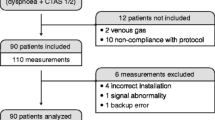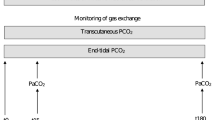Abstract
Purpose
Transcutaneous CO2 monitors are widely used in neonatal ICUs. Until recently, these devices performed poorly in adults. Recent technical modifications have produced transcutaneous CO2 monitors that have performed well in adults with chronic illnesses. We evaluated the accuracy of one of these devices, the TOSCA® 500, in adults admitted to an emergency department for acute respiratory failure.
Methods
We prospectively collected 29 pairs of simultaneous transcutaneous arterial CO2 (PtcCO2) and arterial CO2 (PaCO2) values in 21 consecutive adults with acute respiratory failure (acute heart failure, n = 6; COPD exacerbation, n = 8; acute pneumonia, n = 6; and pulmonary embolism, n = 1). Agreement between PaCO2 and PtcCO2 was evaluated using the Bland-Altman method.
Results
Mean arterial oxygen saturation was 90%, arterial oxygen tension ranged from 32 to 215 mmHg, and PaCO2 ranged from 23 to 84 mmHg. The mean difference between PaCO2 and PtcCO2 was 0.1 mmHg, and the Bland-Altman limits of agreement (bias ± 1.96 SD) ranged from −6 to 6.2 mmHg. None of the patients experienced adverse effects from heating of the device clipped to the earlobe.
Conclusion
PtcCO2 showed good agreement with PaCO2 in adults with acute respiratory failure.


Similar content being viewed by others
References
Crawford A (2004) An audit of the patient’s experience of arterial blood gas testing. Br J Nurs 13:529–532
Zaloga GP (1990) Evaluation of bedside testing options for the critical care unit. Chest 97:185S–190S
Thorson SH, Marini JJ, Pierson DJ, Hudson LD (1983) Variability of arterial blood gas values in stable patients in the icu. Chest 84:14–18
Eberhard P (2007) The design, use, and results of transcutaneous carbon dioxide analysis: current and future directions. Anesth Analg 105:S48–S52
Rosner V, Hannhart B, Chabot F, Polu JM (1999) Validity of transcutaneous oxygen/carbon dioxide pressure measurement in the monitoring of mechanical ventilation in stable chronic respiratory failure. Eur Respir J 13:1044–1047
Sanders MH, Kern NB, Costantino JP, Stiller RA, Strollo PJ Jr, Studnicki KA, Coates JA, Richards TJ (1994) Accuracy of end-tidal and transcutaneous pco2 monitoring during sleep. Chest 106:472–483
Cuvelier A, Grigoriu B, Molano LC, Muir JF (2005) Limitations of transcutaneous carbon dioxide measurements for assessing long-term mechanical ventilation. Chest 127:1744–1748
Maniscalco M, Zedda A, Faraone S, Carratu P, Sofia M (2008) Evaluation of a transcutaneous carbon dioxide monitor in severe obesity. Intensive Care Med 34:1340–1344
McVicar J, Eager R (2009) Validation study of a transcutaneous carbon dioxide monitor in patients in the emergency department. Emerg Med J 26:344–346
Parker SM, Gibson GJ (2007) Evaluation of a transcutaneous carbon dioxide monitor (“Tosca”) in adult patients in routine respiratory practice. Respir Med 101:261–264
Bendjelid K, Schutz N, Stotz M, Gerard I, Suter PM, Romand JA (2005) Transcutaneous pco2 monitoring in critically ill adults: clinical evaluation of a new sensor. Crit Care Med 33:2203–2206
Kagawa S, Otani N, Kamide M, Gisiger PA, Eberhard P, Severinghaus JW (2004) Initial transcutaneous PCO2 overshoot with ear probe at 42 degrees c. J Clin Monit Comput 18:343–345
Roupie EE (1997) Continuous assessment of arterial blood gases. Crit Care 1:11–14
Acknowledgments
We are indebted to A. Wolfe for helping to prepare manuscript.
Author information
Authors and Affiliations
Corresponding author
Rights and permissions
About this article
Cite this article
Gancel, PE., Roupie, E., Guittet, L. et al. Accuracy of a transcutaneous carbon dioxide pressure monitoring device in emergency room patients with acute respiratory failure. Intensive Care Med 37, 348–351 (2011). https://doi.org/10.1007/s00134-010-2076-1
Received:
Accepted:
Published:
Issue Date:
DOI: https://doi.org/10.1007/s00134-010-2076-1




